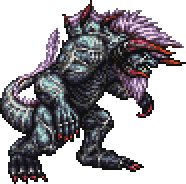I would like to note that this is Humbaba:
And that dude is clearly not a "Dragon". Which brings us to other issues:
What is a Dragon in myth and what is a Dragon in religion and are those things shared or merely conflated by later authors and readers?
That's -separate- from the fact that Chaos is -also- subject to the same linguistic issues across time, region, and language.
As noted, Chaos among several early religions referred more to "Nothingness" that Creation came out of or set an "Order" to by having something exist in a structured way. When we look at the Ocean as perceived by early Mesopotamians we might see the same "Nothingness" from which creation comes.
And yet the Seas are predictable as clockwork. The tides roll in and out with the moon's phases, the tidepools teem with life, and the water itself is filled with life from the microscopic to the largest life on Earth.
But then there's unintentional, or intentional, mingling of cultures into history. Take, as example, the first several lines of the Enuma Elish. The Babylonian Creation Myth, as translated by Lambert.
Demiurge. A word that absolutely did not exist in the Babylonian tongue, which carries lots of connotations based on modern theological interpretation. (Specifically because of Christian theology)
The Demiurge is the creator. It's Greek for Craftsman or Maker. It was a term coined by Plato to describe the "One" who created everything. The origin of logic and ideas who fashioned the universe based on ideas.
But it is often construed to mean antagonistic opposite to the divine or central figure of a religious belief thanks to the structure of the early christian and jewish gnostics framing the matter of creation as a hidden "True God" and the Tetragrammaton as a lesser "Creator" deity who was actually antagonistic toward the true god.
By including the word "Demiurge" in his translation of the text, W.G. Lambert has unintentionally(?) created a line of antagonism between Apsu and Tiamat even as they work together to create the other gods. That she is the secondary, lesser, and antagonistic deity through the use of a term that wouldn't exist until nearly 2,000 years after the Enuma Elish was written.
And he applied it over 2,000 years after the term was created, but 1,700 years after it took on the secondary, Gnostic, definition.
.... but still. This is how Humbaba is used by Final Fantasy:
Because sometimes people use the old name for a new character and completely reinvent that thing into what they wanted and that 'becomes' the standard going forward. Becomes the cultural ideal of what the -original- is, because of a widespread later creation.


